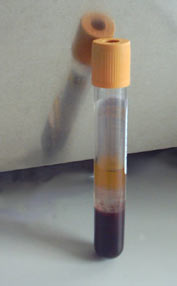Engineering:Serum-separating tube
Serum-separating tubes, also known as serum separator tubes or SSTs, are test tubes used in clinical chemistry tests requiring blood serum.
SSTs are sometimes called "marble-top tubes", "tiger-tops", or "gold-topped tubes", referring to the stoppers which are either gold, red with a gold ring on top, or marbled red and grey. The stopper of SPS (sodium polyanethol sulfonate) tubes have a paler yellow colour, sometimes causing confusion; these are known as "yellow tops" not "gold". Trademarked versions of the SST include Covidien "Corvac" tubes.
The tubes have micronized silica particles which help clot the blood before centrifugation, and a gel at the bottom which separates whole blood cells from serum.[1] Silica nanoparticles induce coagulation through contact activation of coagulation factor XII (Hageman factor).[2] The silica particles are desiccants, which adsorb and hold water vapor.[3] This is used in the tubes so the blood adheres to the surface of the tiny silica particles and begins to clot. After the blood sample is centrifuged, the clear serum should be removed for testing.[4][5]
These tubes should be used with care when measuring drug or hormone levels because the drug or hormone may diffuse from the serum into the gel, causing a reduction in measured level. The gel in SST II tubes (which appears slightly less opaque) is supposed [weasel words] to have less effect on drug levels in serum. [citation needed]
See also
References
- ↑ "Greiner Bio-One VACUETTE Z Serum Sep Clot Activator Tubes - Non-ridged (pull cap) - Blood, Hematology and Coagulation Testing Products, Blood Specimen Collection" (in en). https://www.fishersci.com/shop/products/serum-tubes-clot-activator-gel-separator/22040536.
- ↑ Ilinskaya, Anna N; Dobrovolskaia, Marina A (June 2013). "Nanoparticles and the blood coagulation system. Part II: safety concerns". Nanomedicine (London, England) 8 (6): 969–981. doi:10.2217/nnm.13.49. ISSN 1743-5889. PMID 23730696.
- ↑ (in en) How Does Silica Gel Work?, https://www.youtube.com/watch?v=2OsLyBXH3rA, retrieved 2022-12-16
- ↑ "Blood sampling in sheep". Purdue University. 2003. http://www.ces.purdue.edu/extmedia/AS/AS-557-W.pdf.
- ↑ Thavasu PW, Longhurst S, Joel SP, Slevin ML, Balkwill FR (1992). "Measuring cytokine levels in blood. Importance of anticoagulants, processing, and storage conditions.". J Immunol Methods 153 (1–2): 115–24. doi:10.1016/0022-1759(92)90313-i. PMID 1381403.
 |


